- Why do we make it? (significance)
we want to make something helpful and interactive in our daily life.
In the previous Group Project, our team presented the magic mirror, which can help people choose clothes faster and more effectively, and solve the problem of recycling discarded clothes. In this activity, my inspiration is that what we should do should be helpful to life and have practical meaning to life. Therefore, starting from our own life, we carried out research, hoping to do a project to improve our daily life. My partner Mary and I often go to the library and find that although the study room of the library has a noise detector, it does not tell us clearly how many decibels above is noisy and how many below is quiet, which is vague. At the same time, the noise detector was just showing numbers, not interacting with people. It was very dull and boring. I believe that interaction should be the corresponding response of the machine after thinking and processing human behavior. People’s different behaviors should correspond to different results, while the noise detector in the library only has two kinds of behaviors, namely receiving and output, instead of “processing” and “analyzing” people’s behaviors.
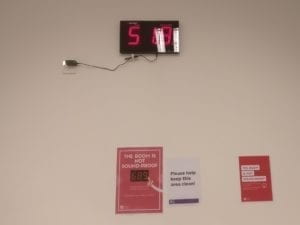

(noise detector in the library.)
- What does it do? (context)
Remind the users of the noise in an interactive way and help the children to comprehend
The box man brings the number to life by adding a “processing” on the basis of the original noise detector. That is to say, box man no longer simply receives and displays the decibel, but converts it into an action. Different noise levels have different actions. Also, it’s more interactive, because box man tries to interfere with your behavior after you make a sound, it interacts with you through different actions, and if people see it react and stop talking, then they connect with it.
We saw a project on Facebook about recycling books in a children’s library, and it was so cute that kids were willing to donate books and knew how to do it.
https://www.facebook.com/kayla.casiello/videos/10162253998475597/
Therefore, we think that the target of this product is school library, and it is more inclined to young children, who have no concept of the number of noise detector, but can better understand box man’s behavior.
- How does it work?
make different actions according to different decibels
We wanted to make a more explicit, vivid, interactive noise detector. Mary Shared a Korean video, in which all the toys can interact with people, and different small figures have different reactions.
So, we wanted to make a box man who could make different actions according to different decibels. Normally, the box man was reading a book.
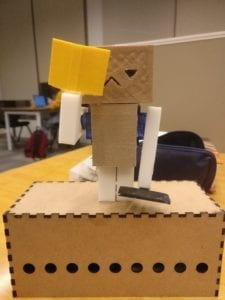
When the volume was low, he would put the book down. 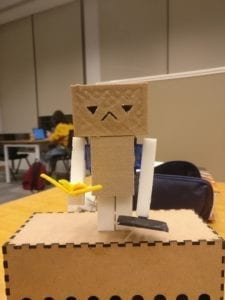
When the volume is relatively high, a sign will be put up saying “silence”.
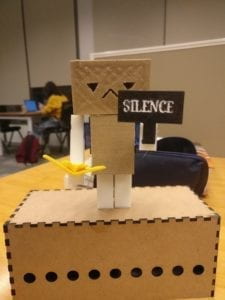
When the volume is constantly high, it will move the sign up and down for several times to protest.
- How was it made?
Tinkercad, 3D printing, motor, arduino, breadboard, plank, laser cut
The principle that we choose materials and technologies is that we have a certain foundation and understanding of them. Our materials are tinkercad, 3D printing, motor, arduino, breadboard and plank. We first used tinkercad to draw box man’s head, body, limbs, books and signs saying “silence” and then printed them with 3D printer. At the same time, two small motors are used to turn the arms, arduino and breadboard are used to connect the circuit to the computer. Finally, a wooden box was cut and assembled with laser cut to load wires, arduino and breadboard, making the product more beautiful. The reason why we choose to use 3D printing is that we learned relevant knowledge in IMA workshop. 3D printing is the easiest way for us to make it, and tinkercad is also very easy to modify the product.
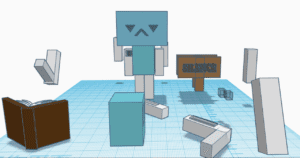
(the model of the box man in Tinkercad)
The reason we chose the motors is because we learned in recitation how to use and compile servo, and we apply it to our product. The whole project is the integration and application of what we have learned, including our knowledge of recitation and lecture.
- Our challenges and solutions
There are four of the most significant steps.
The first is that we have abandoned the school’s sensors and bought four more sensitive sound sensors. The new sound sensor is more sensitive to decibel changes, which makes it easier for our project to monitor noise.
The second is the use of digital output. We consulted Rudi, he gave us a very valuable advice: he suggested that we use the digital sound sensor output rather than analog output, because the arduino identification of analog is insensitive, there will be delay at the same time, while digital only has “yes” and “no” two choices, so we only need to manually adjust the sensitivity, without having to identify the specific values, which helped us save a lot of time and step.
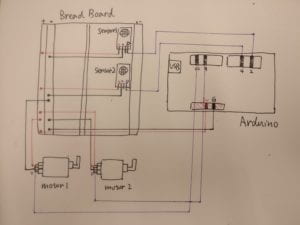
The third one is to solve the delay. We always have a very long delay in the compilation process, so we consulted a staff. He found that our program put pinMode and attach into the loop, which led to the redefinition of each loop and wasted a lot of time. So, we put them in setup, and the latency problem is solved!
The last one is the use of superposition.In the process of our production, we wanted to use three sensors at the beginning, but the third was too insensitive, and must be very very loud that can be detected, so we gave up using the third sensor, but use the superposition method instead. Whenever comes once a second level, it adds 1 (s=0 at the beginning, s= s+1;) When s= 4, it will trigger the third level, that is, lifting up and down the arm. In this way, the third level can be used to detect whether someone is chatting for a long time. If someone is chatting loudly for a long time, the second level will keep appearing, and then when it accumulates to 4, then it will trigger the third level. Abandoning the third sensor makes the design more practical and rigorous (because normally no one speaks very, very, very loudly in the library).
if (s >= 4) {
Serial.println(“NOISY!!!!!!!!!”);
delay(10);
servo1.write(20);//放书
delay(150);//时间加长—————
servo2.write(40);//举
delay(500);
servo2.write(110);
delay(500);//放—–1
s = 0;
} else {//吵
if (sensor2 == 1) {
Serial.println(“NOISY!!!”);
delay(10);
servo1.write(20);//放书
delay(1000);//时间加长
servo2.write(40);//举
delay(3000);
s = s + 2;
Serial.println(s);
delay(10);
t=0;
( part of our coding )
In user testing session, we received a lot of valuable suggestions. For example, one student suggested that action should be generated when the noise is detected for a long time, and also, we should carry out 3D printing in advance to avoid too much printing work. At the same time, another student suggested that we add different colors of LED lights to indicate the noise level, but I thought that the change of LED color might distract students’ study, so I did not adopt the last suggestion.
- Conclusion
In my opinion, the most key of the interaction between human and machine lies in the corresponding response of the machine ( after thinking and processing human’s behavior), that is, “analysis” and “processing”, instead of simply “receiving” and “expressing”. Although our project is a simple interaction, but it reaches my definition of interaction. When I was making the presentation, the audience talked to it, made different volume and observed box man’s reactions. At the same time, some students said that if the cute little robot asked him not to speak, he would follow its instructions. This shows that the audience is willing to communicate with our project and that our interaction is effective.
If I had more time, I would like to replace the current motors with two silent motors, so that box man won’t affect other students when he works. At the same time, I also want to add more actions. During the presentation, a teacher suggested what to do if the children could not understand the word “silence”. I think I can change the sign into other gestures, so as to be more comprehensive to young children.
At the same time, I felt a sense of accomplishment. When I integrated what I had learned into my own project, my heart was full of pride and pride. Especially when it worked, my partner and I screamed with joy. We failed many, many times in the process of making it because the sensor was not sensitive or there was something wrong with the wire. However, we finally achieved our goal and achieved satisfactory results. I think teamwork is indispensable to this. My partner has given me a lot of help. This box man integrates the efforts of both of us and is the crystallization of our knowledge and wisdom.
Through this production, I think the designed products should be close to life, and the products that are valuable and meaningful to life are good products. Meanwhile, interaction makes a product more vivid and aesthetic. I think our box man is just the beginning. There are more unknowns to explore and more to try.
Resources:
- https://www.youtube.com/watch?v=2SJGNwzP-Qs
- https://www.facebook.com/groups/ALAthinkTANK/permalink/2995666503839483/